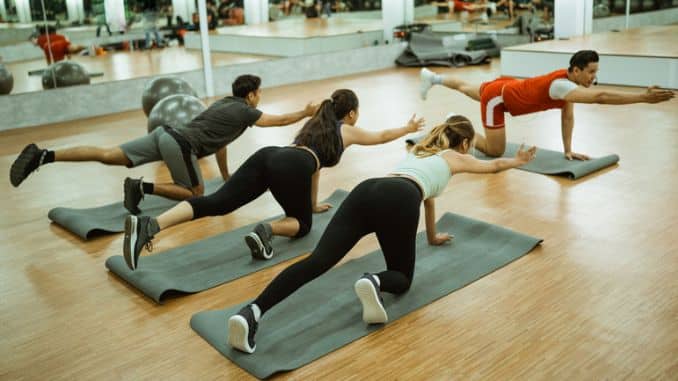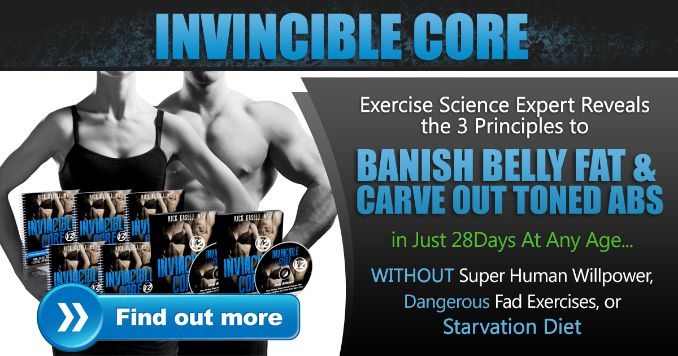If you are looking for something to enhance your workout routine, floor exercises are a powerful way to build muscle, boost flexibility, and improve balance. Exercise strengthens muscles, boosts energy, and improves blood flow, making daily activities easier, especially for those with heart disease. It also enhances bone health and reduces disability risks in older adults.
These simple yet effective moves can transform your training, helping you achieve a stronger, more balanced body. Let’s explore how floor exercises [1] can elevate your fitness journey.
Benefits Of Floor Exercises
1. Core Stability Enhancement
Floor exercises with knees bent help activate deep belly muscles, improving core strength, posture, and reducing injury risk.
2. Caloric Burn And Fat Reduction
Floor workouts like planks and bridges burn calories and help reduce body fat, leading to a leaner shape.
3. Lower Body Strengthening
Starting exercises that focus on the lower body, like hip flexors and floor movements, strengthens legs and glutes. Variations like lifting a leg or lowering slowly increase muscle work.
4. Flexibility And Balance
Floor exercises like planks and balancing on one leg improve flexibility and balance, key for a healthy workout routine.
5. Muscle Mass Development
Including floor exercises like bridges or planks in your workouts helps build and maintain muscle by working several muscle groups at once.
Types Of Floor Exercises For Strength Training
When it comes to strength training, floor exercises offer a wide range of options to challenge your muscles and take your workout to the next level.
Here are a few key exercises to incorporate into your routine:
1. Cat-Cow
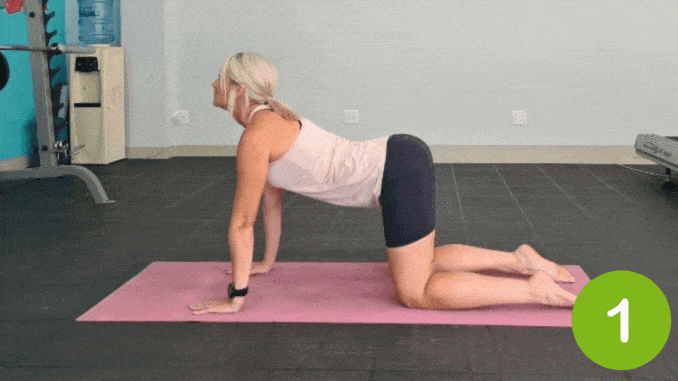
- Begin in a 4-point position with your hands beneath your shoulders and your knees under your hips.
- Inhale and contract your abdominal area.
- Exhale and slowly round out your mid-back as you drop your head downward.
- Then alternate by inhaling as you slowly lift your head and arch your mid-back.
- Repeat the movement, alternating directions.
2. Thread The Needle

- Begin in a 4-point position with your hands beneath your shoulders and your knees under your hips.
- Engage your core.
- Extend your right arm towards your left side, extending as far as possible while maintaining balance and stability.
- Hold this position for several deep belly breaths, in through your nose and out through your mouth.
- Gently return to the starting position and repeat the movement with your left arm.
- To intensify this movement, you can slightly lower your seat towards your feet for a stretch on your lower back.
This exercise enhances lateral flexibility and stability, engaging the core and shoulder muscles.
Variation 1 – Thread The Needle

- Begin in a 4-point position with your hands beneath your shoulders and your knees under your hips.
- Engage your core, rotate your upper body upward, and extend one arm toward the ceiling.
- Rotate back and slide the same arm under your body with your palm facing upward, lowering your shoulder to the floor as you rest the side of your head on the floor.
- Hold this position for several deep belly breaths, in through your nose and out through your mouth.
- Return to the starting position and repeat the movement on the opposite side.
This exercise helps increase shoulder mobility and reduces upper back and neck tension.
Note: Incorporate the shaking fingers and wrist to avoid joint tension.
3. 4-Point Twist
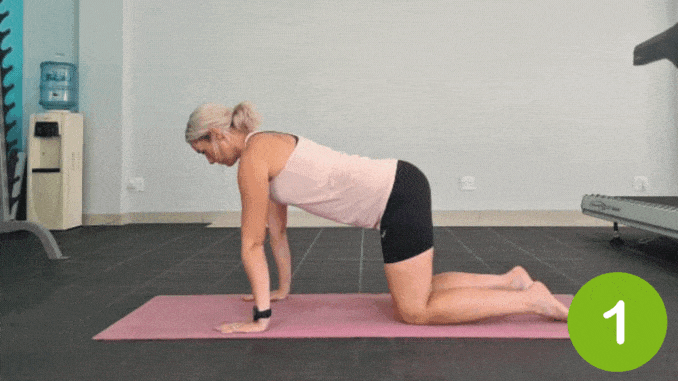
- Begin in a 4-point position with your hands beneath your shoulders and your knees under your hips.
- Engage your core.
- Lift your left leg off the floor and keep it straight with your body.
- Slowly bring your left leg to the right side diagonally.
- Hold this position for deep belly breaths.
- Inhale through your nose and out through your mouth as you return to the starting position.
- Repeat this movement on the opposite leg.
4. Kneeling Side Bend Stretch
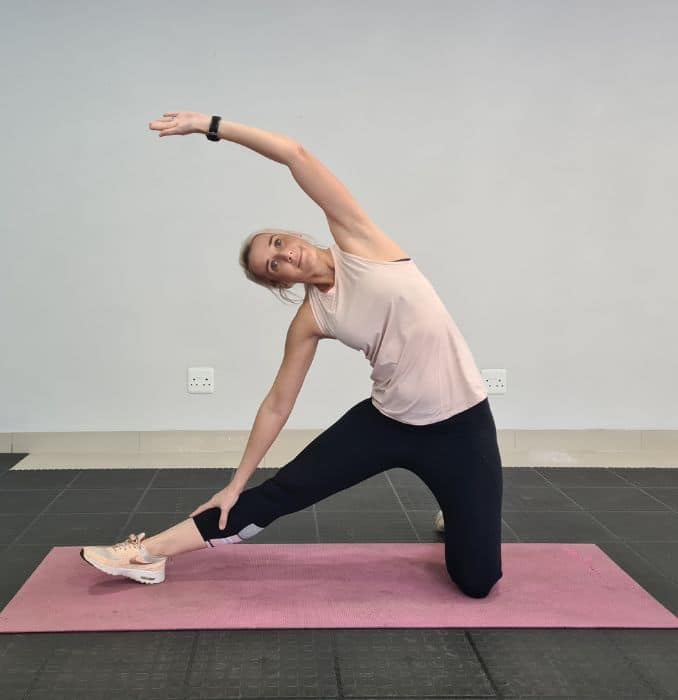
- Begin in a 4-point position with your hands beneath your shoulders and your knees under your hips.
- Engage your core.
- Extend your right leg to the side, with your toes pointing forward.
- Place your right hand on the lower leg for balance and extend your left arm overhead.
- Slowly lean your head and upper body to the right side, creating a gentle bending motion at your waist.
- Hold this position for several deep belly breaths, inhaling through your nose and exhaling through your mouth.
- Gently return to the starting position and repeat the movement on the opposite side.
This exercise enhances lateral flexibility in the spine and stretches the side muscles, improving posture and mobility.
5. Side Reach
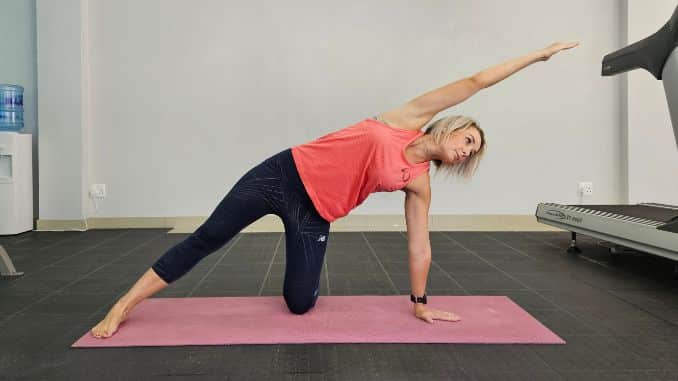
- Begin in an upright kneeling position on the floor, maintaining good alignment with your upper body.
- Engage your core.
- Extend your right leg to the side, foot flat on the floor.
- Press your left hand on the floor as you extend and reach your right hand overhead, creating a line from your right fingertips to your right foot.
- Hold the position for several deep belly breaths, in through your nose and out through your mouth.
- Relax and return to the starting position. Repeat the movement on the opposite side.
This exercise enhances lateral flexibility and engages the muscles along your extended side.
6. Side Reach With Extended Leg

- Begin in an upright kneeling position on the floor, maintaining good alignment with your upper body.
- Engage your core.
- Extend your right leg out to the side, keeping it straight and your foot flat on the floor.
- Inhale and raise your right arm overhead, ensuring it aligns with your right leg.
- As you exhale, lift your right leg slightly and bend your right elbow, bringing it down to meet your right knee in a controlled movement.
- Hold the elbow-to-knee position momentarily, focusing on the contraction of your side muscles.
- Inhale as you extend your arm and leg back to the starting position.
- Repeat this movement sequence as needed, while maintaining steady breathing and a focused engagement of your core and oblique muscles throughout the exercise.
This exercise enhances coordination and balance and strengthens the side body muscles.
Note: After this routine, you can incorporate a little backbend to lessen the tension on your hip and lower back area.

7. Child’s Pose
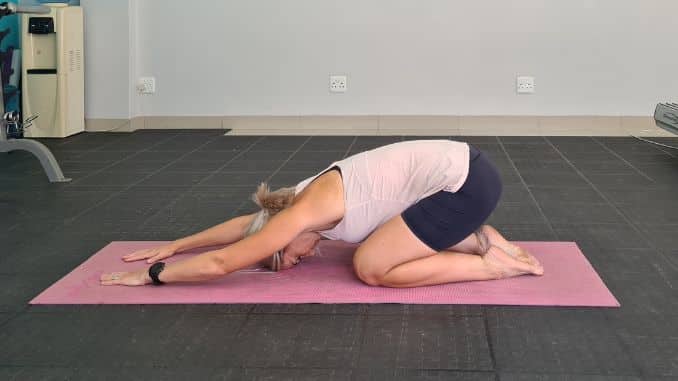
- Begin in an upright kneeling position on the floor with your knees closed together, maintaining good alignment with your upper body.
- Tighten your abdominal area, shift your hips back to your feet, and extend your arms in front or place them on the sides.
- Lower your forehead to the floor, relaxing your mid-back area for a light stretch.
- Hold this position for several deep belly breaths, in through your nose and out through your mouth.
Other Simple Floor Exercises You Can Try At Home
1. Plank

Planks are a classic floor exercise that targets your core, arms, and legs.
- Move into a full plank position, maintaining proper alignment with your head, shoulders, hips, and toes.
- Hold this position for 30 seconds to a minute.
- Take several deep belly breaths, in through your nose and out through your mouth.
2. Glute Bridges
- Lie on your back on the floor with your knees bent and feet flat on the floor.
- Raise both hands towards the ceiling.
- Contract your core and press through your heels to lift your hips towards the ceiling, forming a straight line from your knees to your shoulders.
- Hold the position briefly, then slowly lower your hips back to the starting position.
- Glute bridges target the gluteus muscles, hamstrings, and core, essential for lower body strength and stability.
- This exercise is effective for improving posture, alleviating lower back pain, and enhancing athletic performance.
3. Knee Plank With Kickback
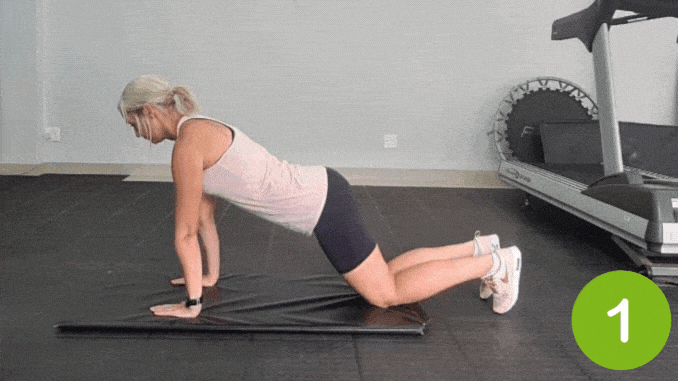
- Begin in a 4-point position with your hands beneath your shoulders and your knees under your hips.
- Engage your core and inhale deeply as you lift your right leg, with your upper leg straight and your knee bent, soles facing upward.
- Return to the starting position and repeat the movement on the opposite leg.
4. Bird-Dog
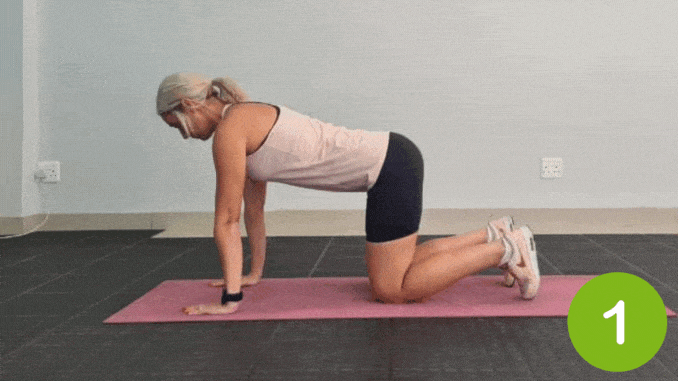
- Begin in a 4-point position, with your hands underneath your shoulders and your knees underneath your hips.
- Contract your abdominal area.
- Take a deep breath and lift one arm to align with your shoulder as you extend your opposite leg behind your body.
- Keep your hips and shoulders parallel to the floor.
- Hold the position for several deep belly breaths, in through your nose and out through your mouth.
- Relax and repeat the movement on the opposite side.
This exercise improves core stability, balance, and coordination.
Equipment And Accessories For Floor Exercises
While many floor exercises can be performed without any equipment, some accessories can enhance your workouts and add variety to your routine.
Here are a few examples:
Yoga Mat: A yoga mat gives you cushion and support while you exercise on the floor. It helps keep you from slipping and marks your workout area.
Resistance Bands: Resistance bands make floor exercises tougher and more effective. They’re light, easy to carry, and can work different muscles.
Exercise Ball: Using an exercise ball makes floor exercises harder by adding instability, which works your core and muscles that help with balance and coordination.
Dumbbells: Dumbbells are flexible and can be used in floor exercises to add weight and boost strength training effects. Begin with lighter weights and slowly go heavier as you get stronger.
Foam Roller: A foam roller helps ease muscle tightness and boost flexibility, especially useful after hard workouts or for specific muscles.
Common Mistakes To Avoid During Floor Exercises
Here are a few mistakes to watch out for:
Improper Form: Keep good posture during floor exercises. Don’t arch your back, hunch your shoulders, or strain your neck. Focus on using your core and keeping your spine straight.
Overexertion: Increase your floor exercise intensity and duration slowly to avoid injuries from pushing too hard too fast.
Lack Of Variety: Doing the same exercises can cause muscle imbalances and get boring. Mix it up with different exercises to target various muscles and keep your workouts fun.
Skipping Warm-Up And Cool-Down: Skipping warm-ups and cool-downs can lead to injuries. Always warm up and stretch after to avoid soreness and stiffness.
Ignoring Your Body’s Signals: Listen to your body during floor exercises. If you feel discomfort or pain, change the movement or stop and ask a fitness expert for help.
Conclusion

Regular exercise [2] helps you stay active and independent as you age. It boosts muscle and heart health, making daily tasks easier and helping you age more slowly compared to those who don’t exercise.
To boost your workout, use accessories like yoga mats, resistance bands, and exercise balls. Mats offer a comfy, non-slip surface, bands increase intensity, and balls enhance balance and core strength, making your exercises more effective.
Ready to transform your core strength and stability? Discover the Invincible Core program and build a rock-solid foundation for a healthier, more active lifestyle. Start today and feel the difference in your posture, balance, and overall strength.

